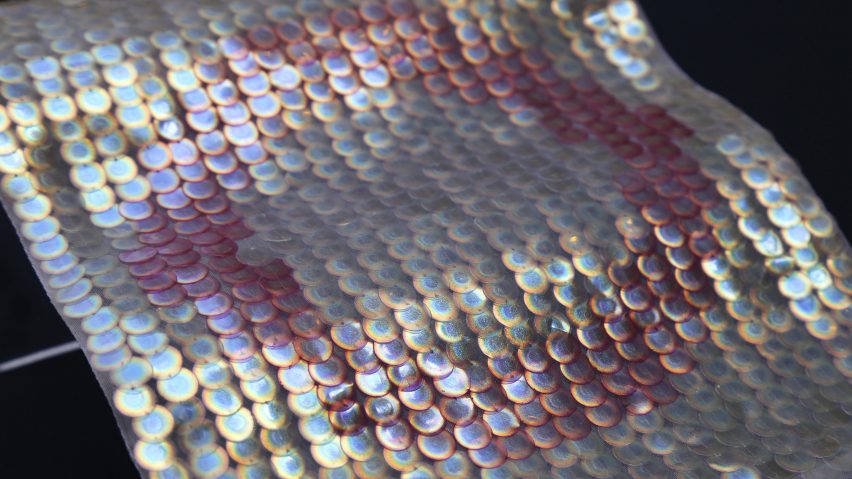A sequinned Stella McCartney bodysuit and styrofoam cups made from mealworms feature in this roundup highlighting innovative design projects that make use of bioplastics.
Bioplastics offer an alternative to traditional plastics, derived from renewable natural materials such as plants as opposed to petroleum.
To fight pollution, many are also designed to be compostable or biodegradable under specific conditions, for example in an industrial composter. However, experts have raised concerns that we currently lack the necessary waste management infrastructure to dispose of these bioplastics correctly.
While the debate about end-of-life wages on, brands and designers are continuing to explore how bioplastics can be used to wean the world off fossil fuels.
Read on for 10 projects from the Dezeen archive that explore different uses for bioplastics:
Radiant Matter sequin bodysuit by Stella McCartney
British fashion brand Stella McCartney recently launched a sleeveless body suit embellished with bioplastic sequins made from tree cellulose by material innovation company Radiant Matter.
The sequins were developed as a substitute for petroleum-based plastic embellishments, which the brand says can contain carcinogenic chemicals. Radiant Matter's alternative is made from renewable cellulose extracted from trees, which has a crystalline form that reflects the light and provides the product with a sparkling quality.
Find out more about the sequin bodysuit ›
Calvin Klein gift wrap by Natural Material Studio
Last Christmas, Copenhagen-based Natural Material Studio created a bespoke bio-textile pouch to function as a gift-wrapping alternative for Calvin Klein products during the holiday season.
The material, called Procel, was developed by Natural Material Studio and is made from a protein bioplastic mixed with natural softeners and pigments. The pouches were designed to be reused and can alternatively be recycled. According to the studio, the product is also biodegradable.
Find out more about the biomaterial gift wrap ›
Informed by kelp structures found along the coastline of Malibu, California, the Kelp Mini Clutch is a 3D-printed bioplastic bag created by Black Panther costume designer Julia Koerner for her brand JK3D.
The bag uses bioplastics derived from corn and soybeans for its construction and is 3D-printed to achieve a ribbed, lamella-like form reminiscent of the underside of mushrooms.
Find out more about Kelp Mini Clutch ›
Clingfilm alternative by Great Wrap
Great Wrap is a bioplastic clingfilm alternative, which was designed to break down in a landfill or industrial compost within 180 days.
Australian biomaterials company Great Wrap produces the clingfilm by extracting and plasticising the starch found in waste potato peels. The resulting thermoplastic starch is then compounded with used cooking oil and a starchy root vegetable called cassava to change its polymer structure so it can be used as a stretch film.
Find out more about Great Wrap ›
Bioplastic vinyl by Evolution Music
Music and sustainability collective Evolution Music released a 12-inch vinyl record made from bioplastic following a four-year development process. This was needed to identify a base polymer that acts similarly to traditional PVC but without harmful and emissions-intensive ingredients.
"It is a robust, ecologically secure, compostable material created specifically to act and sound the same as PVC-derived vinyl," Evolution Music CEO Marc Carey told Dezeen.
Find out more about the 12-inch vinyl ›
bFriends desk accessories by Pearson Lloyd for Bene
Hoping to give waste bioplastics a new life, this collection of desk accessories by office brand Bene is made from discarded polylactic acid (PLA) food packaging. The collection's pen pots, trays and phone stands were designed by London studio Pearson Lloyd and 3D-printed by additive manufacturing studio Batch.Works.
According to Batch.Works, the production process produces close to net-zero emissions and once the products are no longer needed, they can be recycled or reclaimed by Bene under a take-back scheme.
Find out more about bFriends ›
Alternative polystyrene packaging by Doppelgänger
Design studio Doppelgänger has developed an alternative to polystyrene foam made from chitin – a biopolymer that is sourced from the exoskeleton of mealworms – a turned it into cups, foam peanuts and other packaging.
The material breaks down in soil in a matter of weeks, according to the studio, while offering shock-absorbent and water-resistant qualities that rival its petroleum-based counterpart.
Find out more about the polystyrene substitute ›
BreaZea room divider by Crafting Plastics and Office MMK
BreaZea is a 3D-printed room divider made from a scent-infused bioplastic. It was created by design studios Crafting Plastics and Office MMK, who presented the object at Salone del Mobile in 2021.
The room divider uses one of Crafting Plastics' Nuatan bioplastics, which are made from a blend of PLA and PHA polyester. BreaZea has a natural scent reminiscent of bread and maize, in an attempt to mimic the way that fresh wood can add a pleasant aroma to an interior.
Algae sequin dress by Phillip Lim and Charlotte McCurdy
In 2021, fashion designer Philip Lim and industrial designer Charlotte McCurdy teamed up to develop a petroleum-free dress covered in bioplastic sequins.
McCurdy created the sequins by binding algae together using heat and placing it in a custom mould to cure and solidify. The bioplastic was cast into sheets and then cut out into tusk-shaped sequins, which were used to cover an A-line dress designed by Lim.
Find out more about the algae sequins ›
Bioplastic Skin by Valdís Steinarsdóttir
Bioplastic Skin is a food packaging made from boiled animal hides that was designed to dissolve in hot water and biodegrade in a matter of weeks.
The project was developed by Icelandic designer Valdís Steinarsdóttir, who wanted to find new ways of reusing the waste produced by slaughterhouses. As part of the same project, the designer also created Just Bones – a sturdier material made from ground animal bones, which she turned into a series of vases.
Find out more about Just Bones ›

